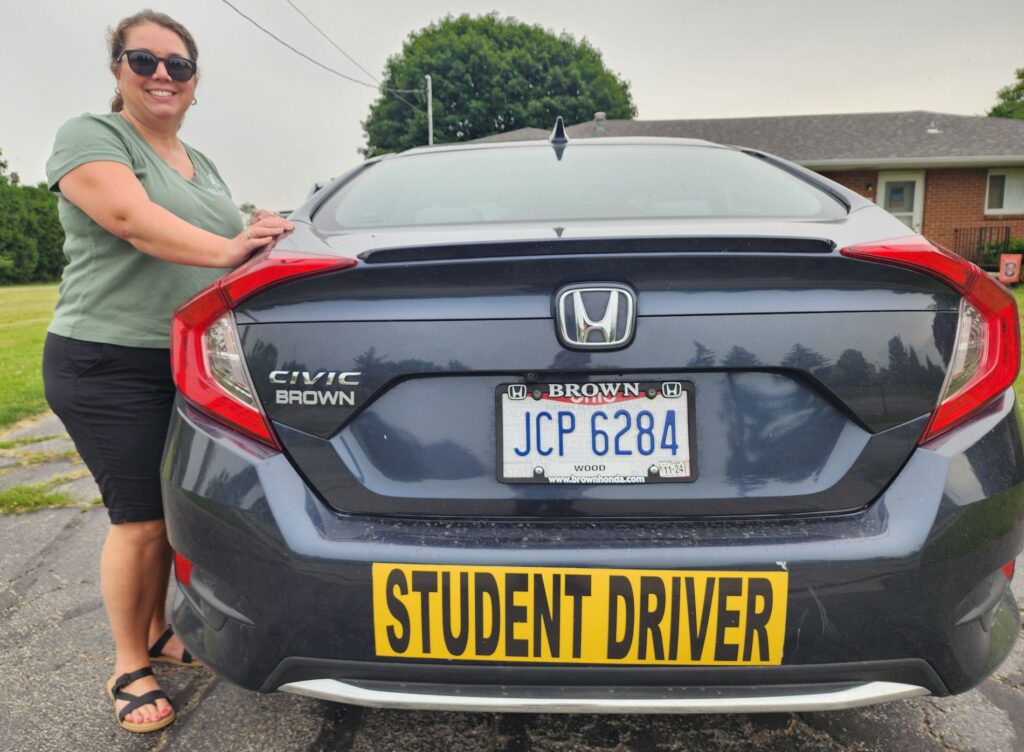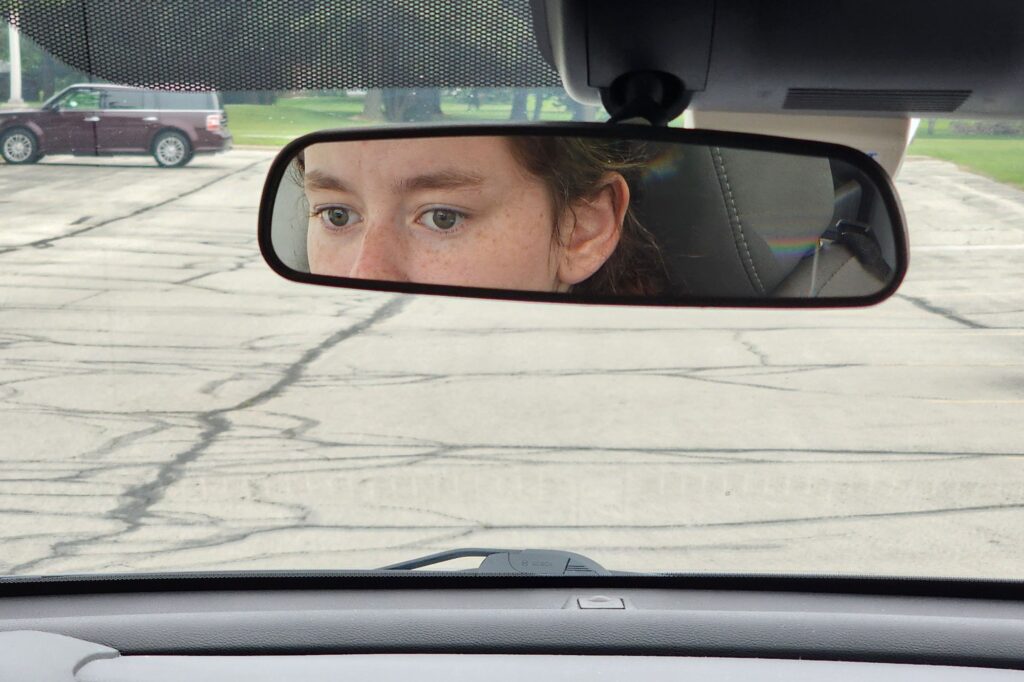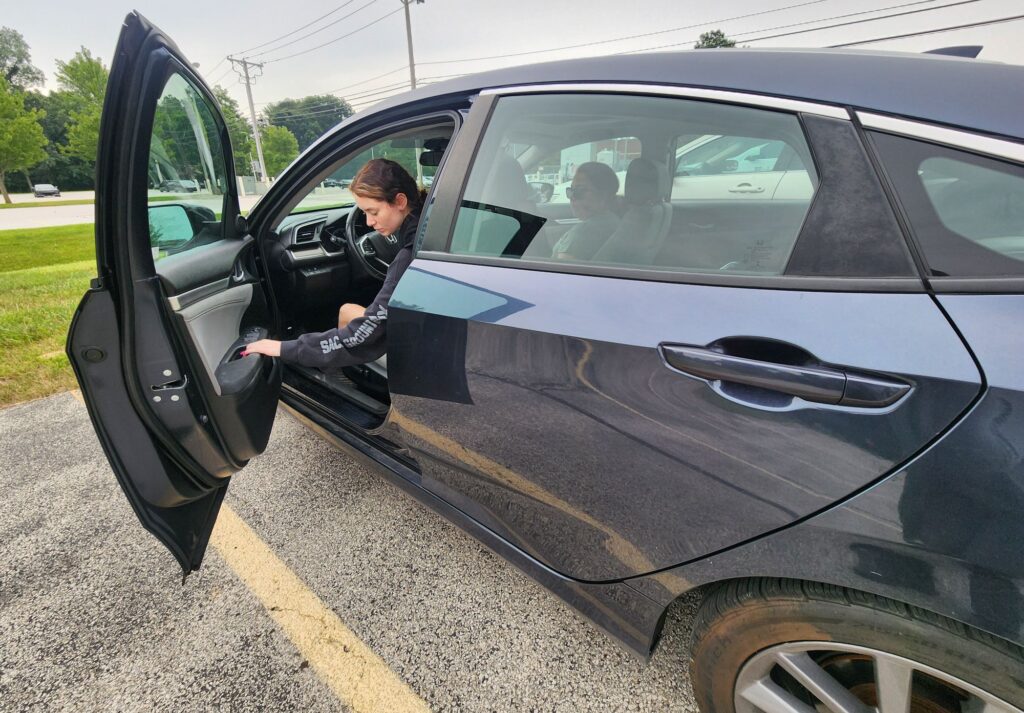By JAN McLAUGHLIN
BG Independent News
Teaching driver education might be right up there with bomb technician or tightrope walker when it comes to stressful jobs.
But all it takes is patience, a firm grasp of the rules of the road, and quick footwork to press the brake pedal on the passenger side of the car.
Just ask Heather Bauer, who with her husband, Rodney, owns Black Swamp Driving School, based in Luckey. She has been instructing young drivers for five years – and she’s yet to meet a novice driver who doesn’t need more confidence, and sometimes less acceleration.
“They’re always nervous,” at least at the beginning, Bauer said.
Most two-hour sessions on the road are uneventful. But not all. One student freaked out and came to a stop every time she saw brake lights ahead. Another student hit a deer. And sometimes they learn that accidents can happen close to home.
“We had a kid back into his own mailbox,” Bauer said with a smile.
Instructors have to intervene – often.
“We don’t grab the wheel,” she said. But the extra brake does get a workout. “I use it every day.”
Bauer doesn’t expect perfection from student drivers. Afterall she taught her kids to drive. To put her students at ease, Bauer often shares her teenagers’ mishaps on the road.
“My own daughter put me in a ditch,” she said.
And her son insisted on taking the drivers test even after Bauer told him he wasn’t ready.
“Boom – he hit the first cone,” and had to retake the test, she said.

Not like the old days
It used to be that drivers education classes were part of the standard curriculum offered for high school students. That’s no longer the case, leaving some teenage wanna-be drivers learning many of their road skills on a screen, and parents scrambling to find classes that offer hands-on practice.
That’s where Bauer enters the picture, and the passenger seat.
She started the drivers ed business with one car, and is now up to seven cars and nine instructors.
As an eighth grade language arts teacher at Anthony Wayne, Bauer is accustomed to working with teens. In some ways, teaching young drivers has a quicker satisfaction rate. It can be very difficult to gauge whether or not students are grasping language arts lessons – whereas, seeing if young drivers are understanding the rules of the road can be immediate.
“By the end of two hours with one student, you can really see tremendous growth,” she said.
Teens can get their temporary permits at 15½ years old, then test for their licenses at age 16. Most kids are timid behind the wheel when they start out, with exceptions …
“You also have the farm kids, who have been backing up trucks with trailers, and who have been driving since they could touch the pedals,” she said. Bauer’s passenger side brake gets plenty of use with those students.

On the road
When Bauer schedules two-hour driving sessions – to reach the magic eight hours driving with an instructor – she isn’t messing around.
“You will not be hanging out at a restaurant. You will be driving the whole two hours,” she said.
The radio is off, but there’s a lot of conversation. They drive on snowy roads and in light fog. They travel country roads bordered by deep ditches, on Interstate 75, and downtown Toledo.
“We go everywhere,” she said.
Since most teens are juggling several demands on their schedules, Bauer tries to make drivers ed time convenient. She picks up or drops off students at their homes, from their part-time jobs, after football practice or at the pool.
Some lessons take a little while to sink in – like checking the blind spot when changing lanes.
“Just because you’ve put on your blinker doesn’t give you a free pass to go,” she cautions students.
A stop sign isn’t a suggestion, and those lines on the road are there for a reason.
Some mistakes turn into teachable – though awkward – moments. Like when a student advances into an intersection to turn left at a traffic light behind another vehicle also turning left. When the light turns red, the first vehicle can proceed, but the student’s car is left sticking out in the intersection.
Then there’s the overarching lesson – “with freedom comes responsibility.”

Behind the wheel
During a recent driving session, Bauer and her student traversed the streets of Bowling Green. This was the final class for Carmen Pioch, 16, of Bowling Green.
“You have to drive as if everybody else doesn’t know what they are doing,” Bauer reminded her student.
Bauer told Pioch to turn into the parking lot at Wood County Hospital to practice navigating a parking lot and pulling in and out of spaces. The lesson included reminders to use the turn signal before maneuvering into a parking spot, and straightening out the wheels once in the space.
Pioch dutifully followed instructions, then peeked out her door to check if the car was straight.
“Excellent, right in the center,” Bauer said.
The backing out process was a little more difficult, with some traffic to contend with.
“Take your time. Slowly creep out,” Bauer instructed. “You have to be aware of everybody all the time.”
The process was repeated several times.
“Ooooo, that’s gonna be a little tight,” Bauer said at one parking space. “Go a little bit slower, you can make corrections.”
Bauer interjected some humor to put Pioch at ease.
“Our daughter hit the garage once,” she said.

Testing trauma
No matter how much practice time they’ve had on the road, many novice drivers are petrified about taking the test to get their license. The most dreaded portion is the maneuverability test, where they have to navigate around cones without hitting them.
Bauer always shares her words of wisdom.
First, she tells students to practice the maneuverability portion in the car they will be using for the test.
Second, keep quiet about their testing time.
“Don’t tell people when you are taking the test. Relieve that pressure.”
Next, remove the fast food wrappers and dirty gym socks before the test.
“Make sure their side of the car is clean,” she advises.
And remember the testing officials are human.
“Mind your manners. Be friendly. Don’t be fake, but be friendly.”
Parents or family members can assist by helping their teen meet the state requirement of 50 hours on the road before testing.
“Ten or 15 minutes every day makes a huge difference,” Bauer said.
Fearless instructors
Teaching young drivers means being confined in a small space with teenagers as they test out their road skills.
“It’s kind of a stressful job,” Bauer said.
Most of the instructors hired by Bauer are teachers, retired police officers or truck drivers.
“All of them like kids and are easy going.”
One of those instructors is Tracy Hovest, a teacher and president of the Bowling Green Board of Education.
“I thought it was a good way to marry being a teacher and making sure kids are safe,” Hovest said.
So far, Hovest has not encountered any frightening moments on the road with novice drivers.
“They are just lacking confidence,” she said. “I have a brake on my side and I can use it to slow them down.”
Hovest tries to gauge the capabilities of each driver to know where to hit the road. She might initially steer clear of country roads with deep ditches and stay off the expressway – and instead start in a parking lot.
Occasionally, other drivers on the road don’t help, Bauer said. The “student driver” decals tend to make truck drivers give a wide berth, but seem to annoy other drivers.
“I think sometimes it makes people really impatient,” Bauer said. “And I’m thinking, ‘Come on, you all went through this.”

